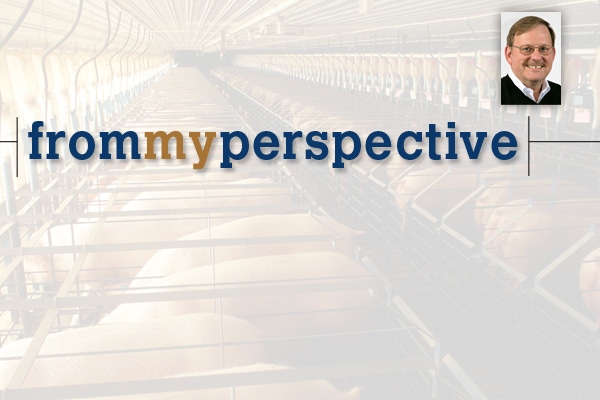Challenges Abound
The when-it-rains-it-pours analogy seems to fit the challenges facing the pork industry recently. It’s an old idiom often used when a disproportionate number of trials and tribulations have befallen someone.
September 15, 2012

The when-it-rains-it-pours analogy seems to fit the challenges facing the pork industry recently. It’s an old idiom often used when a disproportionate number of trials and tribulations have befallen someone.
It seems that every time we turn around (another idiom) pork producers come face to face with yet another challenge. We entered the New Year by documenting widespread cases of new strains of porcine reproductive and respiratory syndrome (PRRS). Record acres of corn were planted earlier than normal this spring, but soon reports of rain-starved crops began to unfold and with them, dashed any hopes for record yields.
Next came carefully edited and selectively distributed undercover videos of standard husbandry practices that sent farm and industry spokespeople to news conference podiums to again reassure the general public that great care is taken to ensure the well-being of the animals within our care. Still, the tally of retailers and fast-food restaurants calling for the elimination of gestation stalls continues to climb.
By July and August, producers and their families were ready for some relief from the day-to-day work and worry and refocused their energies on their county and state fairs. But relief was not to be as news reports about another variant of swine influenza had surfaced, placing the news media, public health care officials and the public in a tizzy.
Moving Forward
Another popular idiom — don’t cry over spilt milk — is tempting here, but we all know that ignoring the problems will not make them go away. Here are a few scattered thoughts about the bumpy months ahead:
Cut the sow herd. Sows are being sold in droves. Avoid panic selling; think through a plan that makes sense for your operation. Keep your lender posted.
Move toward later weaning. Unless you have farrowing crates sitting empty, this management change will necessitate trimming the sow herd. It also reduces the amount of more costly early weaning diets fed. Generally, reproductive performance (conception and farrowing rates) will improve.
Upgrade genetics. A little extra effort to tap into the highest indexing dam and sire lines when demand is soft can pay production dividends later.
Reduce stocking density. Given more space and less competition, pigs’ abilities to convert expensive feedstuffs to premium pork should improve.
Study sow housing alternatives. If you are at all inclined to move from housing gestating sows in stalls to pens, now might be a good time to get started. Do your homework. Set aside a portion of your gestation housing — say 50% — for the transition. Although cull sow prices are down, removing the least-productive sows will lower your feed bill and provide operating space so you and your employees can develop the skills needed to breed, feed and manage sows in groups. Much of the current industry workforce has never managed sows in groups, so build standard operating procedures, but be willing to change them as your knowledge base builds.
On a cautionary note — think through how a phase-in approach will impact employee incentive programs. Make adjustments. Their buy-in is critical.
Manure as an asset. There was a time when you may have traded away your hog manure for the rights to build a barn. Those days are gone.
In a recent conversation with Steve Weiss, president of NUTRIQUEST, he pointed out that the values of the principal components of manure — nitrogen, phosphorus and potassium — are worth 200% more than just 10 years ago.
In the corn-soybean stronghold of the Midwest, Weiss estimates the value of manure in a farrow-to-finish operation can tally up to $6.00/pig. Naturally, the value varies with source — gestation, nursery, finisher — and is limited to a crop’s ability to utilize the nutrients. Sampling and analyzing soil and manure source are necessary to ensure manure nutrients are applied where they are needed most.
Weiss shared another interesting tidbit, based on responses to a survey that represented 1.3 million sows, noting the value of swine manure, today, is up to twice the cost of application. By his calculations, capturing 100% of fertility value from sow manure could be worth up to $1.10/pig produced, while nursery manure was worth $0.45/pig and finisher manure value was up to $4.45/pig.
Yet the survey indicated that no producers were capturing all of this value and, on average, producers were only capturing a percentage of application cost (40% for sows, 58% for nurseries and 86% for finishing).
With the financial challenges that lie ahead, if you have not considered the intrinsic value of hog manure, you may be leaving some money on the table.
You May Also Like



